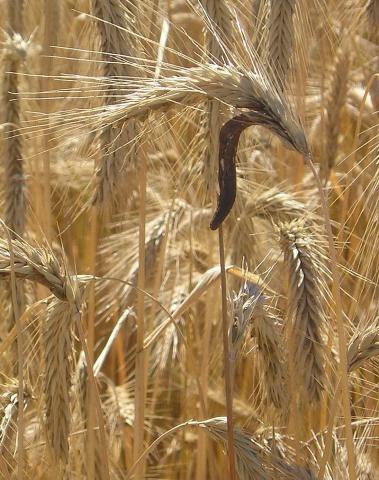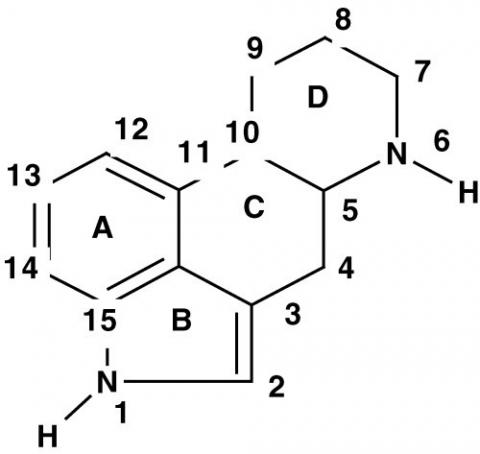Ergot, ergotism and feed regulations
By Harinder Makkar, International Consultant and Adjunct Professor, University of Hohenheim, Stuttgart, Germany
E-mail: makkar@uni-hohenheim.de
Introduction
All species of the Claviceps genus within the Hypocreales infest family of true grasses (Poaceae). This includes grains like rye, wheat, oat, rice, corn and barley. Ergot, is a disease of cereal crops and grasses and is caused by fungi of the Claviceps genus. The word ergot is derived from the old French word for the cockerel’s spur “argot”. Claviceps includes about 50 known species, mostly in the tropical regions. The sclerotia of Claviceps species are known as ergot. Ergot alkaloids (EAs), also denoted ergolines, produced by the fungi are responsible for ergotism. Although the crop loss caused by ergot is important, the toxic effects of the EAs on animals and humans is of much greater significance. EAs are classified as tryptophan derived alkaloids and their physiological effects have been known since biblical times. Today, the cause of the disease is well known, and the condition is known as ergotism. Economically significant species include Claviceps purpurea, which is known to infect more than 400 plant species and can cause ergotism in humans and livestock who consume grains contaminated with its fruiting structure called ergot sclerotium.
Signs of ergot on plants
The sign of ergot is the dark purple to black sclerotia (ergot bodies) which replace the grain in the heads of cereals and grasses just prior to harvest.
Ergot (Claviceps purpurea) sclerotium in rye (Secale cereale). Photo credit: Dominique Jacquin
The ergot bodies consist of a mass of vegetative strands of the fungus. In some grains, ergot bodies are larger than the normal grain kernels; and in other grains, such as wheats, grain kernels and the ergot bodies may be almost similar in size.
Barley (Hordeum vulgare) grains contaminated by ergot (Claviceps purpurea). Photo credit: Dominique Jacquin
A larger size separation between the sclerotia and the grain kernel simplifies the removal of sclerotia. Most of the sclerotia can be removed from infected grains with modern cleaning machinery, unless the sclerotia are similar in size to the grain or broken pieces are present. However, it is costly and often difficult to remove enough sclerotia to meet the legal standards, and traces left could prove toxic to livestock. The prevalence of ergot is higher during wet seasons. Wet weather and wet soils favour germination of the ergot bodies. Susceptibility to infection increases with any condition that may prolong flowering or cause sterile florets. Rotation of cereals and grasses with non-susceptible crops for one year or longer can help to control ergot. The ergot sclerotia usually do not survive in the soil for more than one year.
Ergot alkaloids
Most of the naturally occurring EAs contain a tetracyclic ergoline ring system (Figure 1).
Figure 1. Tetracyclic ergoline ring
More than 50 different EAs have been identified and their amounts and patterns vary between fungal strains, host plant and geographic regions. They are classified into four major groups based on the substitutions at C-8. These are: Clavine alkaloids and 6,7-secoergolenes, Simple lysergic acid derivatives, Ergopeptine alkaloids – cyclol ergot alkaloids, and Ergopeptam alkaloids – lactam ergot alkaloids.
A diagnosis of ergot poisoning can be done based on the presence of the sclerotia in the feed and the exhibition of symptoms of ergotism in animals, or on the presence of EAs in the ground feed.
Ergotism symptoms in animals
The ergotism symptoms in animals are:
- Early signs usually start in the hind limbs. Lameness may start from two to six weeks after first ingesting ergot.
- Hyper-excitability, belligerence, nervous dysfunction, ataxia or staggering, trembling and shaking, wryneck, lying down, convulsions and backward arching of the back.
- Gangrenous ergotism involves the extremities of the animal including nose, ears, tail, and limbs. It occurs due to the constriction of blood vessels, resulting in decreased blood flow in the extremities. The gangrenous tissue is called ‘dry gangrene’. Eventually all affected tissues will slough. The tips and distal areas of the extremities will also slough.
- Feeding of large amounts of ergot grains over time causes loss of portions of hooves, ears, tails, combs, and wattles.
- Spontaneous abortion and loss of milk could also occur in cows and sows fed even small amounts of ergoty feeds. Ergoty feed should then not be fed to breeding females.
Treatments
The treatment for ergotism is to remove the ergot-contaminated feed or remove the animals from the contaminated pasture. If nervous signs are present, painkillers can be administered. If dry gangrene is present, the affected portion will be sloughed. Although the exact mechanism of action at the receptor level is yet to be elucidated, most of the adverse effects of EAs can be associated with interactions with α- adrenergic, dopaminergic and serotonergic receptors.
Legislation
The following legislations exist:
- EFSA Scientific Opinion (2012) on Codex standards for ergot sclerotia provides a limit of 0.05% for oats (CODEX STAN 201-1995), and wheat and durum wheat (CODEX STAN 199-1995). The Commission has proposed to extend this as a common limit for ergot sclerotia in cereal grains (wheat, barley, oats, rye and spelt) and include it in the annex of the contaminants legislation (EC) No 1881/2006. It was acknowledged that it was only a rudimentary measure as it is possible to have high levels of EAs in grain with very little or no visible sclerotia content due to its breaking down. These levels would be reviewed in the near future and could be modified based on the data collected from monitoring exercises. Currently there are no maximum levels specified for EAs by the EC or CODEX.
- In the EU, undesirable substances in feed are regulated by Directive 2002/32/EC. EAs are not listed as such in the Annex of this Directive. However, the Directive sets a maximum content for rye ergot (Claviceps purpurea) of 1000 mg/kg in all feed containing unground cereals. The maximum content relates to a feed with a moisture content of 12%.
- According to the FAO Food and nutrition paper 81 “Worldwide regulations for mycotoxins in feed and food in 2003”, following regulatory levels have been established for ergot and/or EAs in a few countries outside the European Union: in Australia and New Zealand a maximum level of 500 mg/kg of ergot sclerotia in cereal grains is applied. In Canada, guideline levels for ergot sclerotia have been determined for the grading of cereal grains ranging from 0.01% for the highest quality grades, up to 0.1% for the lowest quality grades. Furthermore, maximum levels have been established for EAs of 6 mg/kg in pig feed, of 3 mg/kg in feed for cattle, sheep and horses and of 9 mg/kg in feed for chicks. In Uruguay, a guidance level for EAs in animal feed was issued, providing that EAs should not be detectable in feed for pigs and female rabbits and a guidance level of 450 μg/kg in other feed.
According to the EFSA (2012) opinion, there is no evidence that EAs are transferred from animal feed to animal products and therefore these are unlikely to be an important source of human exposure to EAs.
Further reading
- EFSA (2012). Scientific opinion on ergot alkaloids in food and feed (2005): Ergot alkaloids in food and feed. EFSA Journal 10(7): 2798 (http://www.efsa.europa.eu/sites/default/files/scientific_output/files/main_documents/2798.pdf)
- FAO (2004). Worldwide regulations for mycotoxins in food and feed, FAO Food and nutrition paper 81, FAO, Rome (http://www.fao.org/3/a-y5499e.pdf)
Disclaimer: The views expressed in this publication are those of the author.




